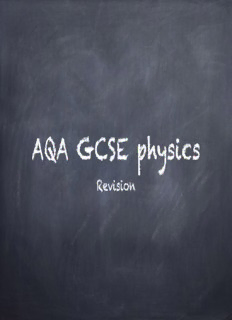
AQA GCSE revision PDF
Preview AQA GCSE revision
AQA GCSE physics Revision P1 Energy, Waves 1.1 Infrared-radiation Energy transferred by electromagnetic waves All objects emit IR radiation The hotter an object is, the more radiation it emits per second 1.2 Surfaces and radiation Dark, matt surfaces emit infrared radiation more quickly than light, shiny surfaces. Dark, matt surfaces absorb infrared radiation more quickly than light, shiny surfaces. Light, shiny surfaces reflect more infrared radiation than dark, matt surfaces. 1.3 States of matter Flow, shape, volume and density are the properties used to describe each state of matter. The particles in a solid are held next to each other, vibrating in their fixed positions. The particles in a liquid move about at random and are in contact with each other. The particles in a gas move about randomly and are much farther apart than particles in a solid or liquid 1.4 Conduction Metals are the best conductors. Materials such as wool and fibreglass are good insulators. Conduction in metals is mainly due to free electrons transferring energy inside the metal. Non-metals are poor conductors because they do not contain free electrons. 1.5 Convection Convection is the circulation of a fluid (liquid or gas) caused by heating it. Convection only occurs in fluids. Heating a liquid makes it less dense so it rises and causes circulation. 1.6 Evaporation and condensation Evaporation is when a liquid turns into a gas. Condensation is when a has turns into a liquid. 1.7 Energy transfer by design The rate of energy transfer to or from an object depends upon: the shape, size and type of material of the object. the materials the object is in contact with. The temperature difference between the object and its surroundings. 1.8 Specific heat capacity The greater the mass of an object, the more slowly its temperature increases when heated. The rate of temperature change in a substance when heated depends on the energy transferred to it, its mass and its specific heat capacity
Description: